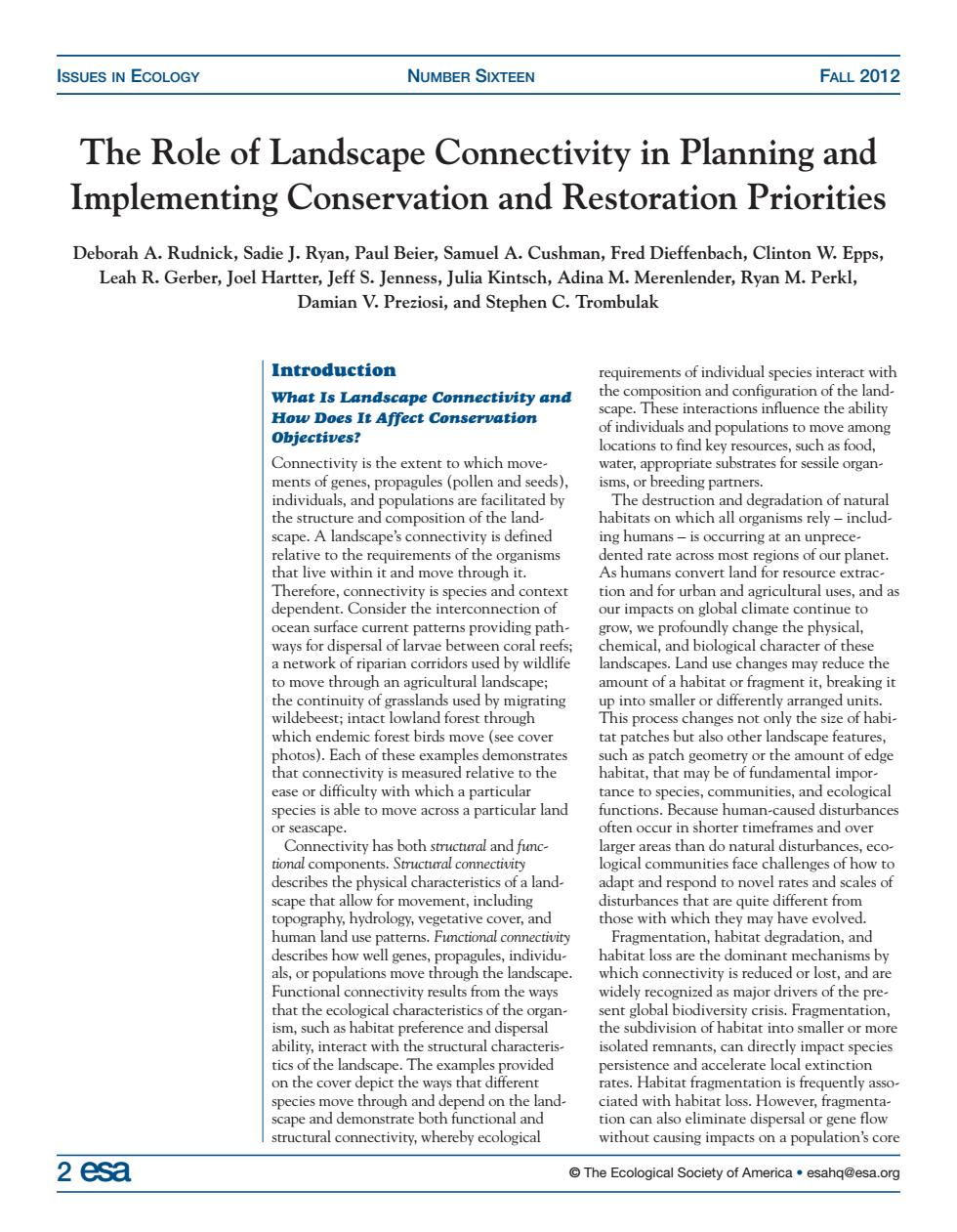正在加载图片...

ISSUES IN ECOLOGY NUMBER SIXTEEN FALL 2012 The Role of Landscape Connectivity in Planning and Implementing Conservation and Restoration Priorities Deborah A.Rudnick,Sadie J.Ryan,Paul Beier,Samuel A.Cushman,Fred Dieffenbach,Clinton W.Epps Leah R.Gerber,Joel Hartter,Jeff S.Jenness,Julia Kintsch,Adina M.Merenlender,Ryan M.Perkl, Damian V.Preziosi,and Stephen C.Trombulak Introduction What Is Landscape Connectivity and How Does It Affect Conservation cape. Objectives populations to move among Connectivity is the extent to which move aciate by ane.A landscape's conncctivity is defined ing humans is occurring at an unprece. convert or r s,and as our impacts on global elimate continus to ace patems providing path change the physical educe the o move through an agricultural landscape; amount of a habitat or fragment it,breaking it oomgating photos).Each of these examples demonstrates seascape ften time ame and over Connectivity has th str and fumnc atur physical characteristics of a land- daptand ap movement,incding amdoowdah gy,vege ve cover,and ma ules,individu habitat lossar the dominant hanisms by e way ism.such as habitat preference and dispersal the subdivision of habitat into smaller or more pecies move through and depend on the and- ciated with habitat loss.However,fragmenta- scape and demonstrate bot nctional and 2 esa The Ecological Society of Americaesahq@esa.org 2 esa © The Ecological Society of America • esahq@esa.org Introduction What Is Landscape Connectivity and How Does It Affect Conservation Objectives? Connectivity is the extent to which movements of genes, propagules (pollen and seeds), individuals, and populations are facilitated by the structure and composition of the landscape. A landscape’s connectivity is defined relative to the requirements of the organisms that live within it and move through it. Therefore, connectivity is species and context dependent. Consider the interconnection of ocean surface current patterns providing pathways for dispersal of larvae between coral reefs; a network of riparian corridors used by wildlife to move through an agricultural landscape; the continuity of grasslands used by migrating wildebeest; intact lowland forest through which endemic forest birds move (see cover photos). Each of these examples demonstrates that connectivity is measured relative to the ease or difficulty with which a particular species is able to move across a particular land or seascape. Connectivity has both structural and functional components. Structural connectivity describes the physical characteristics of a landscape that allow for movement, including topography, hydrology, vegetative cover, and human land use patterns. Functional connectivity describes how well genes, propagules, individuals, or populations move through the landscape. Functional connectivity results from the ways that the ecological characteristics of the organism, such as habitat preference and dispersal ability, interact with the structural characteristics of the landscape. The examples provided on the cover depict the ways that different species move through and depend on the landscape and demonstrate both functional and structural connectivity, whereby ecological requirements of individual species interact with the composition and configuration of the landscape. These interactions influence the ability of individuals and populations to move among locations to find key resources, such as food, water, appropriate substrates for sessile organisms, or breeding partners. The destruction and degradation of natural habitats on which all organisms rely – including humans – is occurring at an unprecedented rate across most regions of our planet. As humans convert land for resource extraction and for urban and agricultural uses, and as our impacts on global climate continue to grow, we profoundly change the physical, chemical, and biological character of these landscapes. Land use changes may reduce the amount of a habitat or fragment it, breaking it up into smaller or differently arranged units. This process changes not only the size of habitat patches but also other landscape features, such as patch geometry or the amount of edge habitat, that may be of fundamental importance to species, communities, and ecological functions. Because human-caused disturbances often occur in shorter timeframes and over larger areas than do natural disturbances, ecological communities face challenges of how to adapt and respond to novel rates and scales of disturbances that are quite different from those with which they may have evolved. Fragmentation, habitat degradation, and habitat loss are the dominant mechanisms by which connectivity is reduced or lost, and are widely recognized as major drivers of the present global biodiversity crisis. Fragmentation, the subdivision of habitat into smaller or more isolated remnants, can directly impact species persistence and accelerate local extinction rates. Habitat fragmentation is frequently associated with habitat loss. However, fragmentation can also eliminate dispersal or gene flow without causing impacts on a population’s core The Role of Landscape Connectivity in Planning and Implementing Conservation and Restoration Priorities Deborah A. Rudnick, Sadie J. Ryan, Paul Beier, Samuel A. Cushman, Fred Dieffenbach, Clinton W. Epps, Leah R. Gerber, Joel Hartter, Jeff S. Jenness, Julia Kintsch, Adina M. Merenlender, Ryan M. Perkl, Damian V. Preziosi, and Stephen C. Trombulak ISSUES IN ECOLOGY NUMBER SIXTEEN FALL 2012